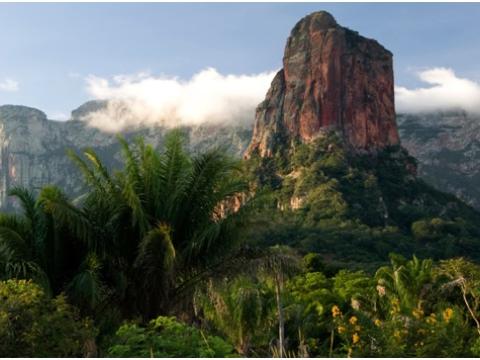Forestry concessions experience lower rates of forest loss than Protected Areas in Bolivia
Many people think logging is a major cause of tropical deforestation, but in this blog post we show that expanding forestry concessions may actually be the best way of protecting the forest in Bolivia.
In 2016, about 5.6 million hectares of Bolivian forest were being used for timber production through long-term forestry concessions (see Map 1). The forestry concessions were located mainly in areas with Amazon rainforest (63%) and Chiquitano dry forest (31%).
Map 1: Forestry concessions in Bolivia, 2016 (5.6 million hectares)
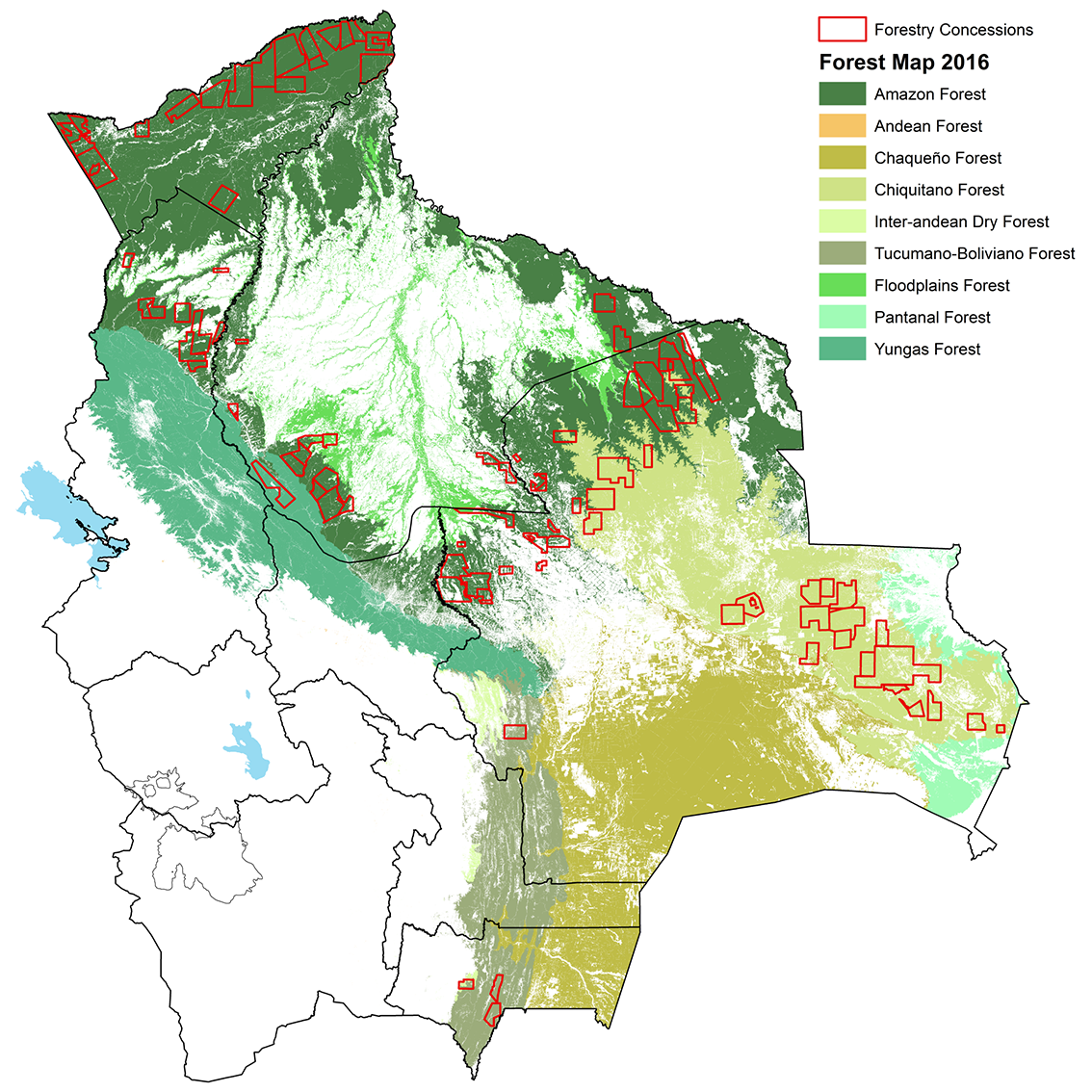
Source: Authors’ elaboration based on data from ABT (2016) and SOB-OTCA (2017).
These areas are supposed to be sustainably managed for selective logging (1), which theoretically does not cause deforestation, as there is no land use change involved. However, in reality, forest cover loss can be detected in these areas. According to forest loss data from Hansen et al. (2013), about 143 thousand hectares of forest was lost within forestry concessions between 2016 and 2021. This corresponds to 2.6% of the total forest area within the concessions over 6 years, or less than half a percent per year. This means that the rate of forest loss within forestry concessions is actually lower than the rate of forest loss within Protected Areas in Bolivia, and much lower than in areas without protection nor forestry concessions (see Table 1).
Table 1: Forest loss within Forestry Concessions, Protected Areas, and other areas in Bolivia, 2016-2021
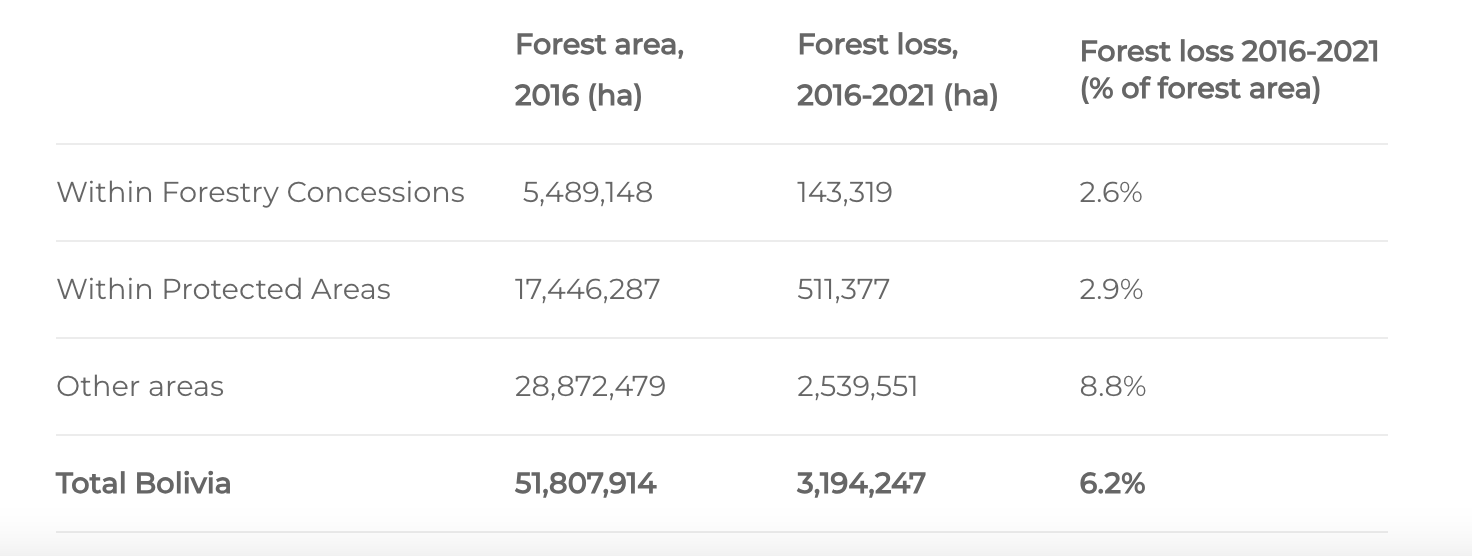
Source: Authors’ elaboration based on data from ABT (2016), SERNAP (2015a, 2015b, 2015c), SOB-OTCA (2017), and Hansen et al. (2013).
While Protected Areas are great for tourism, in the absence of international compensation for carbon sequestration and biodiversity protection, they do not generate much foreign currency revenue for the country (considering current tourism flows).
Forestry concessions are potentially more lucrative (2). In 2022, wood products generated USD 125 million in export revenues, which is close to an all-time high for Bolivia (see Figure 1), and very close to beef exports (USD 128 million). The recent increase in wood exports is mainly due to a tripling of wood exports to China, from around 20 thousand tons before the pandemic, to more than 60 thousand tons in the last couple of years. However, the value of wood exports is far from the USD 2,220 million generated from the exports of soybean products in 2022.
Figure 1: Export of wood and wood products from Bolivia, 1992-2022
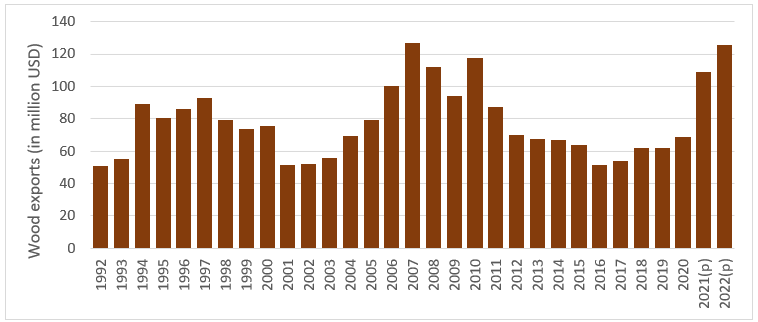
Source: Authors’ elaboration based on data from INE.
Note: Includes the following product categories: “Maderas y manufacturas de madera”, “Fabricación de muebles de madera”, “Papel y productos de papel”. Bolivia does not export unprocessed wood.
With about 50 million hectares of tropical forest, Bolivia has tremendous potential for exporting products based on fine, tropical wood. With selective harvesting on a 20-year rotation cycle, forests and biodiversity can be maintained while at the same time generating the inputs for a prosperous industry based on tropical timber. How prosperous it will be, depends on how much value is added to the wood, but the value of sustainably harvested, minimally processed wood could be at least USD 16 billion per year (see calculations in Table 2).
Table 2: Sustainable timber harvesting potential in Bolivia
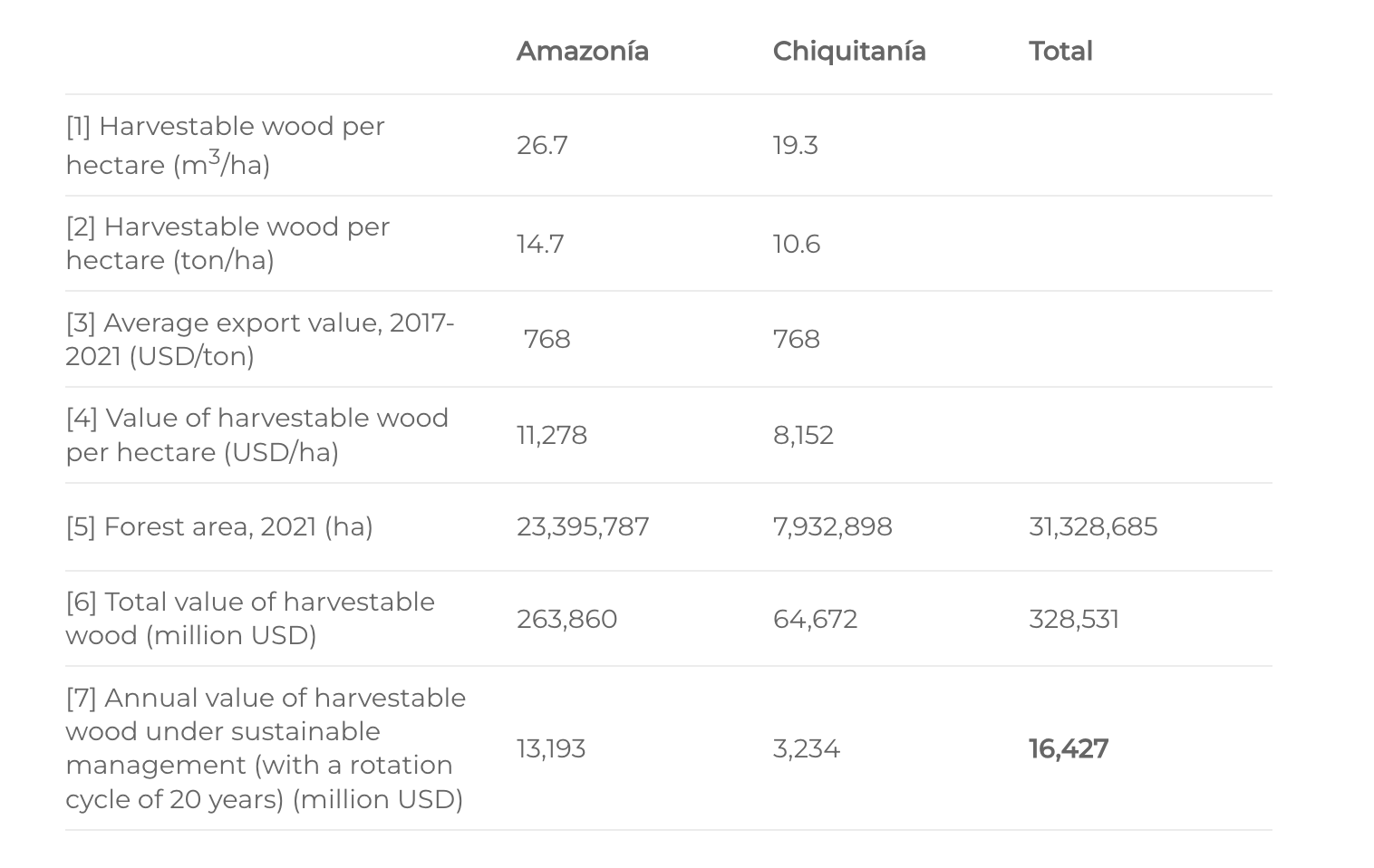
Sources: [1]: CFB (2001, Tables 5 & 30).
[2]: [1] x 0.55 (Ministerio de Agricultura de Chile, 2022).
[3]: (IBCE, 2021).
[4]: [2] x [3].
[5]: Authors’ calculations based on ABT (2016), FAN (2003) and Hansen et al., 2013).
[6]: [4] x [5].
[7]: [6]/20 years.
There are plenty of opportunities to add more value to the wood, however. The value of minimally processed wood is less than 1 dollar per kg, according to the calculations above, but if the wood is turned into final consumer products like parquet floors, doors, furniture, sculptures, handicrafts, or violins, the value can be many times higher.
Given the relatively low rates of forest loss within forestry concessions, and their relatively high economic potential, expanding the area of forestry concessions may be a promising strategy to reduce future deforestation in Bolivia while at the same time generating substantial export revenues. Doubling authorized timber production by 2030 is also one of the goals in Bolivia’s Nationally Determined Contributions (Bolivia, 2022).
In 2005, Bolivia was recognized as the World leader in the sustainable management of tropical forests with 2.2 million hectares of natural forests certified by the Forest Stewardship Council (3). However, the bureaucratic certified forestry sector could not compete against the less regulated agricultural sector, and currently only 9 forest enterprises in Bolivia are certified by FSC (4).
Several changes are needed for the sector to recover and realize its potential. First, a political decision to give the forestry sector another chance. Second, legal and administrative adjustments that make it safer for businesses and communities to invest in the sector (e.g. secure property rights). Third, a simplified tax regime, especially for the indigenous communities which control the production of the raw material. Fourth, access to credit to facilitate the investments needed in all steps of the process of harvesting and adding value to the wood. Fifth, long-run, just and complementary partnerships between the indigenous communities that control the forest lands and the businesses that process and export the wood products. Finally, tree plantations may be an option in some areas where they would not interfere with ecosystem functions. However, a specialized regulatory framework is necessary for plantations, given that these function more like agricultural crops than natural forests.
Footnotes
- Selective logging in natural forests with a mix of species of different ages is very different from wood plantations of a single species of the same age. According to Bolivian rules, every 20 years, individual trees with a diameter above 50 cm can be harvested, in accordance with a Forest Management Plan approved by ABT, that details which individual trees will be harvested, and how they will be extracted.
- Some timber extraction takes place outside forestry concessions, but since this is illegal, the wood cannot be exported and is always at risk of getting confiscated. Timber extraction outside forestry concessions is probably mostly to rescue some valuable timber before burning down the forest to make room for agriculture and pasture anyway, so in this blog we will assume that wood production outside forestry concessions is currently insignificant.
- https://bo.fsc.org/bo-es/newsfeed/historia-del-cfvfsc-bolivia.
- https://bo.fsc.org/bo-es/empresas-con-certificacion-fsc-en-bolivia.

References
Andersen, L.E., Doyle, A.S., del Granado, S., Ledezma, J.C., Medinaceli, A., Valdivia, M., Weinhold, D. (2016) “Net Carbon Emissions from Deforestation in Bolivia during 1990-2000 and 2000-2010: Results from a Carbon Bookkeeping Model.” PLOS ONE 11(3): e0151241. https://doi.org/10.1371/journal.pone.0151241
ABT, Autoridad de Fiscalización y Control Social de Bosques y Tierras (2016). Autorizaciones Transitorias Especiales Bolivia. ABT. Data base available at: http://geo.gob.bo/download/?w=abt&l=AUTRES2016
Bolivia (2022). Nationally determined contribution (NDC) of the plurinational state of Bolivia. Ministerio de Medio Ambiente y Agua – Autoridad Plurinacional de la Madre Tierra. https://unfccc.int/sites/default/files/NDC/2022-06/NDC_Bolivia-2021-2030_UNFCCC_en.pdf
Bolivia (2023). Nivel de Referencia de Emisiones Forestales por la Deforestación del Estado Plurinacional de Bolivia. Versión 1.0. 23 de enero. https://redd.unfccc.int/files/bo_nref_v1_20230123_final.pdf
CFB, Cámara Forestal de Bolivia (2001). Potencial Forestal de Bolivia. Obtained from
https://www.cfb.org.bo/bolivia-forestal/potencial-forestal#Cuadro%203
Hansen, M. C., P. V. Potapov, R. Moore, M. Hancher, S. A. Turubanova, A. Tyukavina, D. Thau, S. V. Stehman, S. J. Goetz, T. R. Loveland, A. Kommareddy, A. Egorov, L. Chini, C. O. Justice, and J. R. G. Townshend (2013). “High-Resolution Global Maps of 21st-Century Forest Cover Change.” Science 342 (15 November): 850–53. Data available from: https://earthenginepartners.appspot.com/science-2013-global-forest
IBCE, Instituto Boliviano de Comercio Exterior (2021). Bolivia: Exportaciones de Madera y sus Manufacturas. BOLETÍN ELECTRÓNICO – IBCE CIFRAS. Obtained from: https://ibce.org.bo/publicaciones-ibcecifras-pdf.php?id=961
INRA, Instituto Nacional de Reforma Agraria (2016). “Parcelas y predios titulados por el instituto Nacional de Reforma Agraria.” Data available from: https://geo.gob.bo/geonetwork/srv/spa/catalog.search#/metadata/f5c31a96-c4f0-4140-ba47-2cfbd931075a
Ministerio de Agricultura de Chile.(2022). Instituto forestal. Estadísticas forestalres. Obtenido de https://wef.infor.cl/index.php/factores-de-conversion/convertidor-de-unidades?view=convertidor_unidades#:~:text=El%20factor%200%2C55%20t,de%20humedad%2C%20edad%20y%20otros
SERNAP, Servicio Nacional de Áreas Protegidas (2015a). “Mapa de áreas protegidas nacionales de Bolivia” Data available from: http://geo.gob.bo/download/?w=sernap&l=areas_protegidas_nacionales042015
SERNAP, Servicio Nacional de Áreas Protegidas (2015b). “Mapa de áreas protegidas departamentales de Bolivia” Data available from: http://geo.gob.bo/download/?w=sernap&l=areas_protegidas_departamentales42015
SERNAP, Servicio Nacional de Áreas Protegidas (2015c). “Mapa de áreas protegidas municipales de Bolivia” Data available from: http://geo.gob.bo/download/?w=sernap&l=areas_protegidas_municipales042015
SOB-OTCA, Servicio Nacional de Áreas Protegidas (2017). “Mapa de Bosques 2016, Bolivia 2017.” Sala de Observación de Bolivia – Organicación del Tratado de Cooperación Amazónica. Base de datos disponible en: http://geo.gob.bo/download/?w=mdmaya&l=bosque_2016

November 21st, 2023
- Log in to post comments

